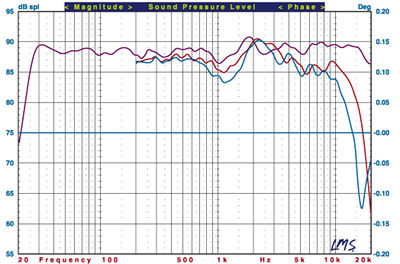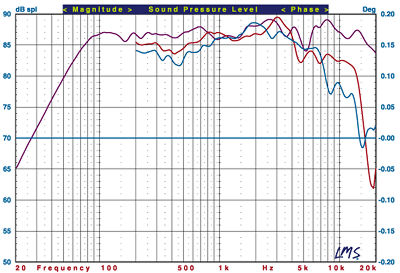Cambridge SoundWorks Newton Series T500 surround speaker system Measurements
The Newton Theater T500 Tower's impedance bottoms out at 4.1ohms at 98Hz. Below 500Hz the impedance rises, which might indicate a capacitor in the mid-tweeter circuit to protect it from overload. (The impedance curve of a loudspeaker such as this, which includes a built-in powered subwoofer, does not provide information about the impedance of the powered woofer section, which would be irrelevant in any case.) I would rate the nominal impedance of the speaker at 5ohms, which should not be a difficult load for any competent amplifier. The T500's sensitivity is approximately 89dB/W/m.
The T500's pseudo-anechoic response at tweeter height, averaged over a 30° forward horizontal angle and combined with the near-field responses of the woofers and port, is shown in Fig.1 (violet). The useful bass extends down to about 23Hz (-10dB relative to the output at 100Hz). The figure shows a wide, smooth frequency response, the single significant deviation being a moderate dip at 1kHz. As we move horizontally off-axis, the high frequencies decrease as expected, and the moderate suckout at 1kHz deepens. But the off-axis result is still better than average. The off-axis vertical-response curves in Fig.2 again show the T500's averaged horizontal front response (violet), plus the vertical responses taken at +15° (red) and -15° (blue) relative to the tweeter. Apart from a small dip below the tweeter in the 2-4kHz region, the off-axis response remains very close to the on-axis measurement.

Fig.1

Fig.2
The cabinet of the center-channel Newton Series MC500 is tuned to 40Hz, with a minimum impedance of 4ohms at 110Hz. A conservative rating for the nominal impedance would be 5ohms. The impedance is very capacitive at 56Hz, but the magnitude is 15ohms at this point, so the speaker should not be difficult to drive. Its sensitivity measured about 87dB/W/m.
The MC500's measured front horizontal response, taken on the tweeter axis and averaged in the same manner as described above for the T500, is shown in Fig.3 (violet). The useful bass extension is approximately 40Hz (-10dB). The response is a little rougher than the T500's, but still good for a speaker at this price. Moreover, the off-axis performance of this 3-way center-channel, while falling off quite a bit at extreme off-axis angles, is free of the midrange suckout that often afflicts 2-way, horizontal center-channel designs. The ±15° vertical off-axis performance of the MC500 is also very good (Fig.4).

Fig.3

Fig.4
The result here is something of a puzzle, as the T500 system's measured results do not indicate a system that should sound as MF describes. It isn't as flat as the Infinity Interlude IL60, which he mentions favorably, but it isn't far enough off to explain the discrepancy. The only explanation I can offer is that there could be a problem in the time domain—perhaps delayed resonances in the response that are affecting the listening results but that don't show up in our small-signal frequency-response curves. A serious cabinet resonance in the midbass, for example, might muddy the sound and make a speaker sound duller than it measures. (You might not think that problems in the bass can affect the treble, but shifts in spectral balance can often have surprising consequences.)—Thomas J. Norton
- Log in or register to post comments





























































